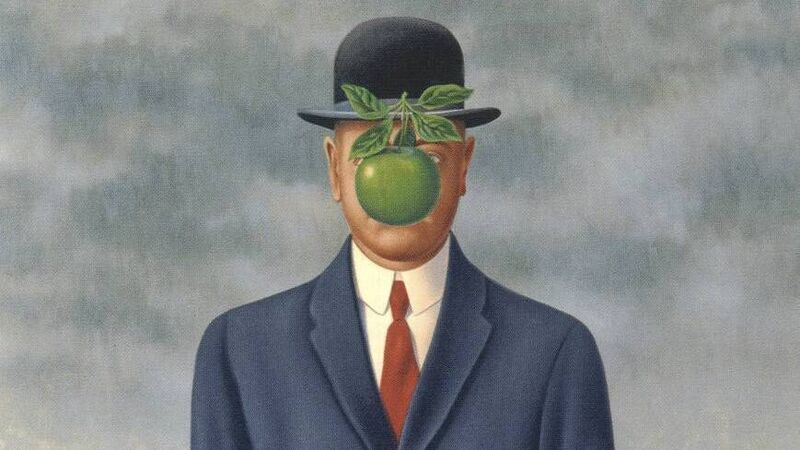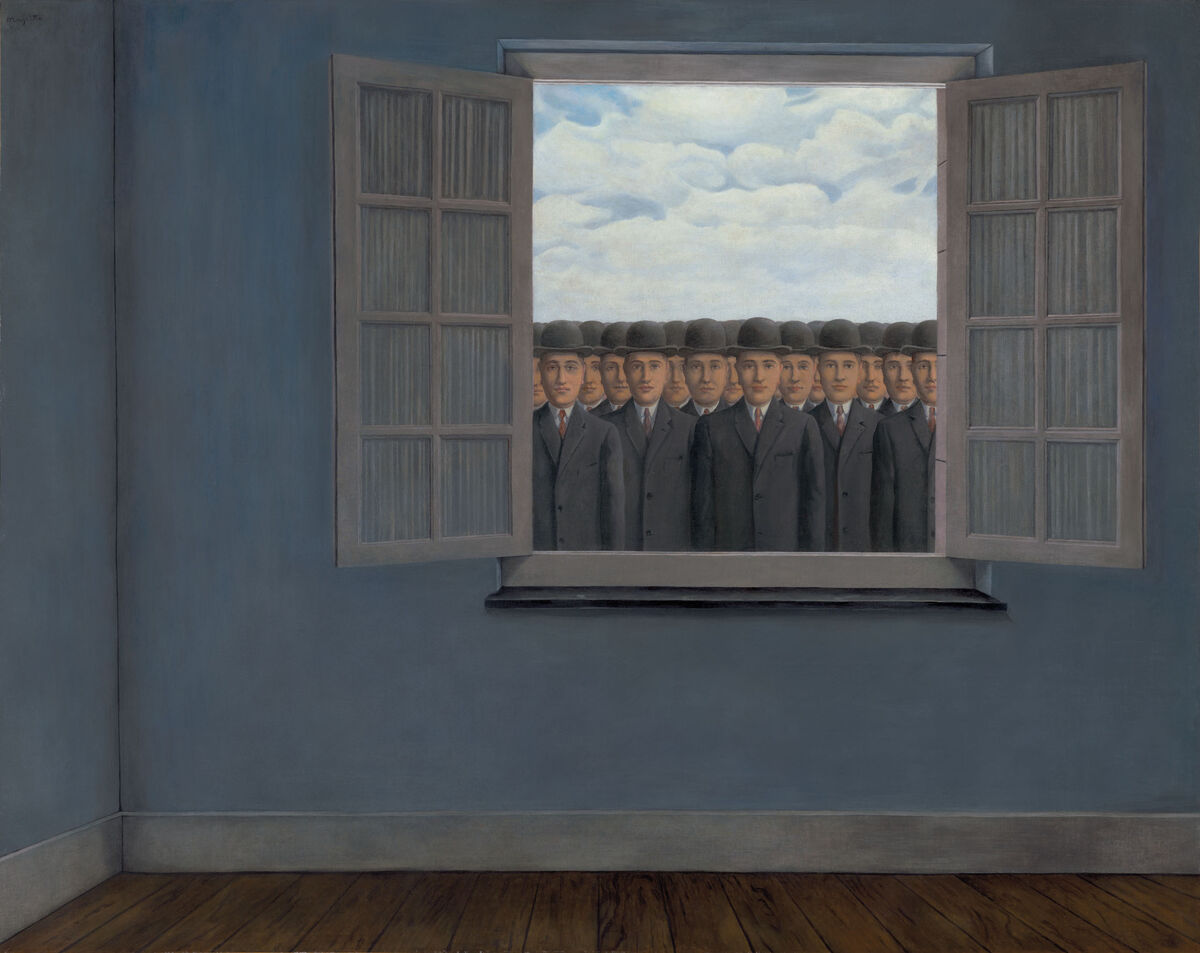Book review: A delightful and definitive biography of surrealist René Magritte

Detail of René Magritte’s ‘The Son of Man’ (1964): The bowler hat in this and other paintings cannot help but amuse. Is it a joke against the bourgeoisie or is there a reference to Charlie Chaplin’s character, the Little Tramp?
A question asked repeatedly as a joke: How many Belgians can you name? Well, here is one: René Magritte, surrealist.
Alex Danchev, author of Magritte: A Life, may not be a household name but is well known in academic cloisters as he has held lectureships, fellowships, and professorships. Danchev’s mother was from Lancashire, but his father’s heritage was not only Belgian (that’s two) but also Bulgarian: he immigrated to the UK in 1939 becoming a citizen in 1945.
Danchev had a quintessential English youth — studying at University College, Oxford, and Trinity Hall, Cambridge — before embarking on a stint as an officer at Sandhurst.
First and foremost a military historian, Danchev’s interests range widely over such fields as international relations, philosophy, poetry, and fine art. His work often weaves these seemingly disparate strands together, bringing understanding across disciplines.
When he first ventured into writing about artists Danchev did not start with his near-compatriot, Magritte. Instead, he looked at Braque, Picasso, and Cézanne. He seems to have segued from one painter to another, often being stimulated during his research process to pursue a new branch of learning. After Magritte came poet Paul Nougé, another Belgian. Sadly, Danchev died, aged 60, and never published on Nougé.
Indeed, the 10th and final chapter of Magritte: A Life was written by Sarah Whitfield, who also edited the proofs.
The posthumous book must be approached with a sense of sadness and regret that Danchev was unable to to complete his project although, through the efforts of his widow, Dee, he lives on in the pages of this delightful and definitive biography of Magritte.
Interestingly Danchev turned to Irish poet Seamus Heaney for his credo: “The imaginative transformation of human life is the means by which we can most truly grasp and comprehend it.”
Danchev felt history was best understood through the eyes of artists who perceived it as their present, and commented on it via their medium. Through the distortions of the surrealism of Magritte and Nougé, for example, might emerge a truer image of the 20th century.

Dee Cooper, signing as Dee Danchev for the purposes of Magritte: A Life, was also an important contributor to her spouse’s thinking. As a psychologist, her insights into human nature stimulated Danchev to think with a different approach. It is possible to sense her influence in Danchev’s presentation of Magritte’s early years in the bosom of his family, who seem to have “nurtured” in him an ironic and disrespectful view of bourgeois society.
When an aunt — deemed “mad” by relatives — died, he and other young scions invaded her home and searched in every nook and cranny for ready cash.
There is little hard evidence of the realities of Magritte’s boyhood but an overload of oral history. Stories about his family may, indeed, have been the foremost entertainment among the citizens of Châtelet. Undoubtedly the tales are tall, embellished if not by their subject — the self-styled gang leader René — then by gossiping villagers. His father, Léopold, was a Walter Mitty clone, living a fantasy life in which he was a man of substance. He was, mostly, absent — away for work or with other women, reminiscent, perhaps, of Willy Loman in Death of a Salesman. His wife, Régina, was depressed and suicidal.
The children, led by the eldest René, ran wild to such an extent that responsible denizens forbade their offspring from associating with the family.
Danchev is wary of psychoanalysing his subject, feeling that it is too easy to jump headfirst into cliché. However, he does linger on the death of Magritte’s mother, who drowned in the River Sambre. Newspapers reported that when her body was dragged out the face was covered by the fabric of her nightdress. The boy was 13 when his mother disappeared and must have been adversely affected by the 17 days that elapsed before she was found. Danchev suggests that the image of his mother’s corpse, lodged in his young brain, might have been the genesis of Magritte’s interest in revealment and concealment.
It was as a child that Magritte began to distort words. This was partly driven by his bilingualism. He conflated his Walloon and French vocabularies to conjure rude and crude words, even inventing advertising copy for pigs’ urine and horse dung.
Whilst this scatological behaviour is not unusual in children, with Magritte the propensity for messing with language stayed with him into adulthood and became an essential constituent of his art.
Louis Scutenaire, a friend who chronicled the artist’s life, stated that Magritte’s painting “proceeds in large measure from his rooted tendency to warp the form of words and above all to alter their meaning”.
Scutenaire continues: “So it goes with elements of his painting which he distorts. And the miracle — or the supreme logic — is that the contradiction asserts its own reality — almost a reflection of the real world.”

He quotes from Magritte’s comments on his ‘The Son of Man’ in which a man’s face is hidden by an apple. “There is an interest,” states the artist, “in that which is hidden and which the visible doesn’t show us. This interest can take the form of a quite intense feeling, a sort of conflict between the visible that is hidden and the visible that is apparent.”
In terms of psychoanalysis, it is very tempting to indulge in some layman’s diagnoses. The bowler hat in this and other paintings cannot help but amuse. Is it a joke against the bourgeoisie, against the type of man who flowed over London Bridge in TS Eliot’s ‘The Waste Land’? Or is there a reference to Charlie Chaplin’s character, the Little Tramp?
Looking at the title of another painting, ‘La grande guerre’ (The great war), it is necessary to consider whether he can have been anything other than traumatised by the world wars he experienced.
In his lifetime Magritte made money out of commercial art, designing all manner of items including posters, record covers, catalogues, and wallpaper. He often collaborated with his wife, Georgette; his brother, Paul; and his friend, Nougé. The three searched for originality, feeling somewhat overwhelmed by more established artists such as the Greek-Italian Giorgio de Chirico.
They shared a feeling perhaps that, hailing as they did from the Belgian bourgeoisie, they could not achieve the world recognition that they sought. This was almost true in that success finally came in 1965, only two years before Magritte’s death at 68. New York’s Museum of Modern Art provided the showcase.
Since his death, images created by Magritte have become ubiquitous. Everyone knows his iconography and the familiar sight/word jokes can sell anything. At the same time, Magritte’s art has not succumbed to exploitation and is still fundamental to great work produced by other virtuosos such as Mark Rothko, John Berger, Jacques Derrida, and The Beatles.
Central to Magritte’s genius was the dislocation that he expressed, between words and the objects to which they refer: Ceci n’ést pas une pipe. Central to Danchev’s genius, of course, is the precision with which he chooses words to say exactly what he means.
Magritte: A Life is a perfect match between signifier and signified. Superb, and a fitting monument to Danchev’s life.
- Magritte: A life by Alex Danchev with Sarah Whitfield
- Profile Books, hb €42







